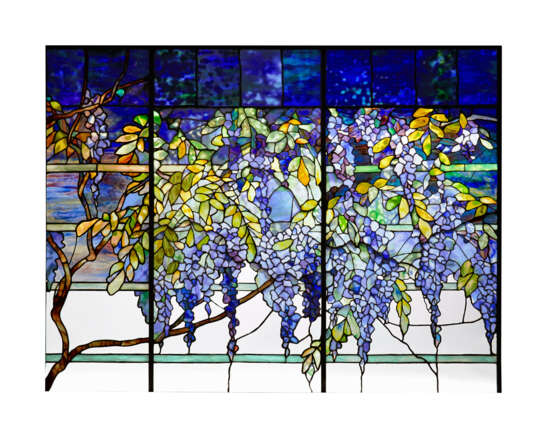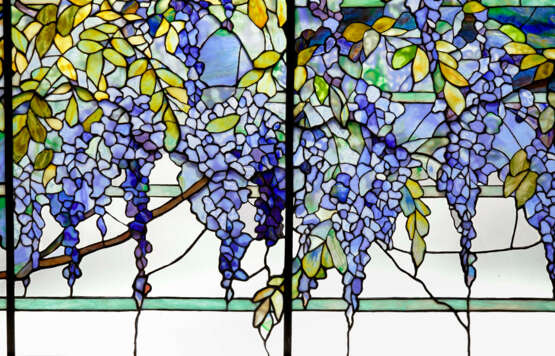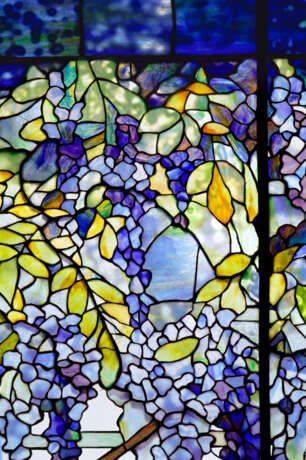ID 773245
Лот 410 | TIFFANY STUDIOS
Оценочная стоимость
$ 700 000 – 1 000 000
Important 'Wisteria' Transom Window from the Dining Room of Louis Comfort Tiffany's Private Estate, Laurelton Hall, Oyster Bay, Long Island, circa 1905
leaded glass
35 x 46 1⁄2 in. (88.9 x 118.1 cm) (sight)
Provenance
Louis Comfort Tiffany, Laurelton Hall, Long Island
Bruce and Adele Randall, New York
The Garden Museum Collection, Matsue, Japan, circa 1990s
Allen Michaan, California, acquired from the above, 2012
Literature
The Extensive Collection of the Louis Comfort Tiffany Foundation, auction catalogue, Parke-Bernet Galleries, Inc., New York, 1946, inside cover (for a period photograph of Laurelton Hall), p. 15 (for the present lot in situ at Laurelton Hall)
G. Speenburgh, The Arts of the Tiffanys, 1956, p. 101 (for the present lot in situ at Laurelton Hall)
H. Winter, The Dynasty of Louis Comfort Tiffany, 1966, p. 137 (for the present lot in situ at Laurelton Hall)
H. McKean, The 'Lost' Treasures of Louis Comfort Tiffany, New York, 1990, figs. 1-7 (for 'Wisteria' transom windows from Laurelton Hall currently in the Morse Museum collection)
T. Horiuchi, ed., The World of Louis Comfort Tiffany A Selection from the Anchorman Collection, Nagoya-shi, 1994, p. 64 (present lot illustrated)
R. Koch, Louis C. Tiffany: The Collected Works of Robert Koch, Atglen, 2001, p. 126 (for the present lot in situ at Laurelton Hall)
T. Horiuchi, A Selection of 300 Works from Louis C. Tiffany Garden Museum, Japan, 2001, p. 80, no. 91 (present lot illustrated)
A. Duncan, Louis C. Tiffany: The Garden Museum Collection, Suffolk, 2004, pp. 152 (for the present lot in situ at Laurelton Hall) and 153 (present lot illustrated)
N. Long, ed., The Tiffany Chapel at the Morse Museum, Winter Park, 2002, p. 23, no. 14 (for 'Wisteria' transom windows from Laurelton Hall currently in the Morse Museum collection)
A. Cooney Frelinghuysen, Louis Comfort Tiffany and Laurelton Hall: An Artist's Country Estate, New York, 2006, cover, pp. 80, fig. 119, 94-95, figs. 149-151 (for 'Wisteria' transom windows from Laurelton Hall currently in the Morse Museum collection), fig. 156 (for the present lot in situ at Laurelton Hall)
Timeless Beauty: The Art of Louis Comfort Tiffany, Atglen, 2016, pp. 114-117 (for 'Wisteria' transom windows from Laurelton Hall currently in the Morse Museum collection)
Post Lot Text
PARADISE LOSTLOUIS COMFORT TIFFANY'S LAURELTON HALL ESTATECompleted in 1905, Laurelton Hall was perhaps Louis Comfort Tiffany’s greatest artistic achievement. Wholly designed by Tiffany, the eighty-four room, eight-level Aesthetic movement showpiece sat on nearly 600 acres overlooking Oyster Bay, Long Island. The entirety of the estate took more than two years to complete at a cost of over two million dollars. Not only did Tiffany specify every detail of the architecture to his exacting standards, but also the creation of the sprawling gardens, the Romanesque terraces, and abundant fountains and pools. As reflected in Tiffany’s many art forms, the exoticism of other worlds clearly presided at Laurelton Hall. An impressive pair of towering ceramic Ming-style Chinese seated Buddhist lions over five feet tall guarded the entrance to the Loggia. These cross-cultural influences seen on the exterior of Laurelton Hall were also witnessed on the interior. The ‘Main Hall,’ featuring an impressive recessed central fountain, was surrounded by Byzantine influenced mosaic tiles covering the walls and extending up two-floors, with limestone columns topped by Asian-inspired capitals at the uppermost registers. A ‘Chinese Carved Red and Gold Lacquer Octagonal Room’ displayed lacquer wares from China and Japan, from the Ming dynasty and Edo period and beyond. And the ‘American Indian Room,’ with multiple shelves holding early basket weavings from the Klickitat and Salishan tribes of North America’s Pacific Northwest, captivated any visitor to Laurelton Hall. The estate was also home to one of the most important Ming Dynasty Imperial Palace carpets ever created (sold at Christie’s New York, 14 October 2020, lot 20, $1,710,000). Amongst this symphony of stimuli seen in the furniture and objects, Tiffany placed the best examples of his Studios' glass in the form of lighting, Favrile glass vases, and impressive stained glass windows. One such example was the transom window for the dining room. This handsome border of cascading Wisteria allowed for easterly light to flood in and blur the line between interior and exterior (see lot 410, the important Wisteria transom, which is one of the original seven created for the estate). Nature was clearly paramount in Tiffany’s surroundings. In 1918, Tiffany created the Louis Comfort Tiffany Foundation, which established Laurelton Hall as a retreat and study center for young artists. Of the eighty-four rooms in the immense structure, many were converted to art galleries of every variety with paintings by several important artists of the time, including a collection of work by Louis Comfort Tiffany himself. This melting pot of artistic notions and pioneering craftmanship provided a breeding ground for education and innovation in American art. In 1946, thirteen years after Tiffany’s death, the Foundation made the difficult decision to liquidate and sell the contents of Laurelton Hall. Parke-Bernet Galleries held the enormous sale of 1,147 lots, Objects of Art of Three Continents and Antique Oriental Rugs, The Extensive Collection of the Louis Comfort Tiffany Foundation, 24-28 September 1946 (see lot 413). The order of sale provided a mix of Tiffany Studio works such as chandeliers, lighting, cabinet vases, enamels and more, along with Egyptian and Roman Antiquities, historic textiles and carpets, Native American baskets, Japanese netsuke and lacquers, and Chinese jades, pottery and porcelains.Sadly, in 1957, the Laurelton Hall estate sustained a fire which consumed much of the structure and left little in its wake. Hugh McKean, a one-time artist in residence and Foundation trustee, and his wife, Jeanette Genius McKean, salvaged what they could from the ruins in order to preserve the glory of the once renowned estate. Key architectural elements that were saved were generously donated to the Metropolitan Museum of Art in New York upon the renovations of the American Art wing in 1978. The largest portion of the treasures from Laurelton Hall can be found in the Charles Hosmer Morse Museum of American Art (Winter Park, Florida). THE PASSION OF THE COLLECTORBRUCE RANDALL AT LAURELTON HALLA devotional pursuit of excellence was in the nature of Bruce Randall (1931-2010). At the age of twenty-one, Randall dedicated himself to weight lifting and competed in key competitions such as World’s Strongest Man. Although never to win the top title, in the summer of 1955 Randall weighed north of 400 pounds and could dead-lift 770 pounds. At what appeared to be peak strength, Randall transformed with all the dedication and perseverance exemplified before to focus on body-building. In less than two years, Randall dropped in weight to 231 pounds and concentrated on physique – he entered an exclusive world of muscle building occupied by only a few. In his own words, Randall endeavored to “look at life from the other side of the weight picture” and in 1959 Randall won the top seated prize of Mr. Universe at the London Palladium. This ferocious drive for distinction permeated many facets of Randall’s life. Drawing inspiration from his father, a noted antiquarian book dealer, Randall approached collecting in the same way he concentrated on his body – with vigor, determination and excellence. As a member of Montgomery Ward’s sports advisory staff, Randall traveled across the country to mentor high school youths in the importance of physical fitness. During these trips, Randall visited antique shops and markets where he encountered works by Tiffany Studios such as lamps, Favrile glass vases and bronze ‘fancy goods’. Not unexpectedly, Randall embarked upon an insatiable hunt for the very best in every discipline to which Tiffany had applied himself. Along the way, Randall acquired a parcel of land at Laurelton Hall, Tiffany’s renowned Oyster Bay country estate, where he would house his growing collection of Tiffany works of art. He came to understand that collecting was more than an a pursuit for the best, it was also an intellectual endeavor and an acute responsibiity to preserve the past.Randall’s message to the world was “Your body is your home…keep it fit.” It’s with this emphasis on perfection that Tiffany too approached his art and life. “It is almost axiomatic with Tiffany that a functional object must also be beautiful, and he achieved this goal in such diverse media as glass, bronze, enamel and pottery.” Bruce Randall too understood the body not only as a functional organism, but also a beautiful one.
| Производитель: | Tiffany Studios |
|---|---|
| Материал: | Стекло |
| Художественный стиль: | Модерн |
| Категория аукционного дома: | Мебель и Светильники, Лампы и светильники |
| Производитель: | Tiffany Studios |
|---|---|
| Материал: | Стекло |
| Художественный стиль: | Модерн |
| Категория аукционного дома: | Мебель и Светильники, Лампы и светильники |
| Адрес торгов |
CHRISTIE'S 20 Rockefeller Plaza 10020 New York США | ||||||||||||||
|---|---|---|---|---|---|---|---|---|---|---|---|---|---|---|---|
| Предосмотр |
| ||||||||||||||
| Телефон | +1 212 636 2000 | ||||||||||||||
| Факс | +1 212 636 4930 | ||||||||||||||
| Условия использования | Условия использования | ||||||||||||||
| Транспортировка |
Почтовая служба Курьерская служба Самовывоз | ||||||||||||||
| Способы оплаты |
Банковский перевод | ||||||||||||||
| Часы работы | Часы работы
|





